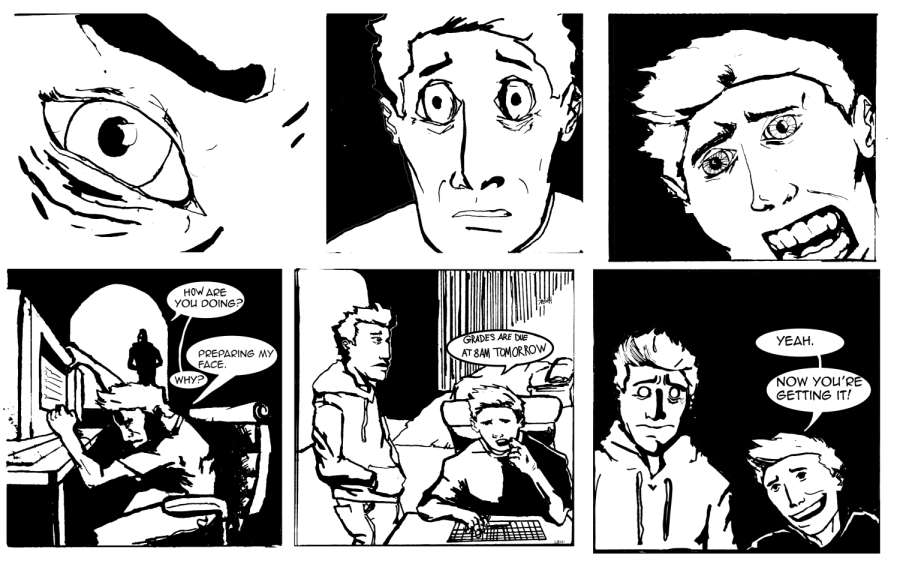The hidden side of education: Teachers experience stress while ensuring students receive a high-quality education
A teacher worries about grades, which are due the next day. Believe it or not, report cards are as stressful for teachers as they are for students.
Sergios Paschalis typically spends eight hours at school, walking home at 3:35. After a short break, he spends the next four or five hours grading and preparing materials for future classes. Meetings, tutorials and parent conferences burn even more daylight.
“Because it’s my first year, I have to prepare a lot of material,” the new Latin teacher said. “There is an extra layer of difficulty in that you need to prepare a lot of things from scratch, so in total I would say it’s 12 hours a day.”
Many students are unaware of teachers’ responsibilities outside the classroom. Neha Mathur, a Chemistry and Biology teacher, starts preparing a month before the school year begins. Teachers must plan tests and quizzes two months in advance; they attend workshops and conferences over the summer; and they meet with their respective departments frequently to adjust the curricula. Grading also takes a significant amount of time.
“We give such detailed lab reports, and this is a school where, if I ask a kid for two sentences, they’ll probably give me 10,” Mathur said. “We try to give quality feedback, and that takes a lot of time.”
A study by the RAND Corporation, found that teachers reported more “job-related stress and symptoms of depression” than the average worker. Covid-19 has exacerbated this issue, and 50% more teachers are “likely to leave their jobs” this year than before the pandemic.
When the St. John’s campus first closed due to the pandemic in March 2020, teachers had to quickly adjust to a new style of teaching. Robert Trujillo, an algebra and precalculus teacher, joined St. John’s for the 2020-2021 school year—online school and the modified five-day schedule lessened his usual workload, but he had to spend time re-writing and scrapping lessons to accommodate for lost days.
“There are so many eraser marks in my calendar from all of the planning that I did and then had to scrap,” Trujillo said. “There has been a lot of actively shifting the curriculum.”
He now has to adjust to this year’s more “robust schedule” after a year and a half of shorter work days.
No teachers have had a typical year in the last two years.
— Robert Trujillo
“No teachers have had a typical year in the last two years,” Trujillo said. “Everyone has felt more tired this year than they have in recent memory. We’re out of shape when it comes to teaching.”
Mathur says that most teachers have readjusted to their heavier workloads and are “in a much better place now.” But, last semester presented a challenge for teachers to meet high educational standards.
“Mentally, we all were just drained,” Mathur said, “but we wanted to keep up that standard. That was creating this tension all around.”
Along with the difficulties of online instruction, the RAND study found that health concerns greatly contribute to teacher anxiety. As some of the first employees returning to on-site work in late 2020—St. John’s reopened for in-person learning that September—teachers were also some of the first to confront the dangers of post-quarantine life, other than essential workers.
Trujillo never experienced much anxiety about teaching in-person during the pandemic since students and faculty were required to wear masks and small class sizes allowed for social distancing. But he knows many teachers at schools with less stringent Covid protocols.
“My friends in public school—they have 30 to 40 kids in a class, there are no mask mandates, there is very little adherence to social distancing,” Trujillo said. “I do recognize the privilege that I have teaching here. That has made me feel better about teaching during Covid.”
But teaching was a time-consuming job before the pandemic; a 2019 survey by Phi Delta Kappan found that half of teachers surveyed considered leaving the profession within the last year. Stress was cited as a major factor.
Mathur says that teachers at St. John’s spare no effort to ensure their students receive a high-quality education. She and the rest of the Science Department collaborate on writing activities, lessons and assessments, updating or scrapping them year by year.
“One thing that separates St. John’s from other schools is the way that teachers work,” she said. “We don’t take questions from a test bank; we make our own questions, and that takes a lot of time. Major assignments—tests, quizzes—have to be done two months in advance.”
Mathur teaches 64 students, all of whom complete a lab every 10 to 12 days. She leaves a comment for every point she takes off, while still grading tests, quizzes and concept checks. Last year, since months of lessons and multiple tests were eliminated amid Covid-19 and winter storm Uri, she had a lighter workload—in the first semester of this year, she had to readjust to her normal, busy schedule.
Writing comments for mid-semester report cards is a significant source of teacher stress. Most teachers take notes on each student in order to prepare, and since English is Mathur’s second language, she keeps a dictionary open while she writes to better express her thoughts.
As a first-year faculty member, Paschalis originally spent 30 minutes writing each comment; eventually, he was able to cut the time in half.
“It’s exhausting for the teachers, but I definitely see their benefits,” he said. “A grade is not enough because students can have the same grade but be so different.”
Paschalis manages the stress of such a heavy workload with his hobbies, including reading and playing guitar.
“Exercise always helps, even only 20 minutes of walking,” he said. “Doing something that doesn’t have to do with a screen is the best thing. Watching stuff on the internet can seem relaxing, but it just makes you a little bit more passive and tired.”
Both Paschalis and Mathur say that students can help their teachers with effective communication. Scheduling tutorials and asking questions as soon as a problem arises helps teachers manage their workloads.
“Holidays are the light at the end of the tunnel. If we can survive that, we’ll be okay,” Mathur said. “But, I love teaching, and that is what is keeping us going.”
Return to package.

Annie Jones ('24) joined The Review in 2020 as a freshman. She has four younger siblings and considers herself the wunderkind of shenaniganery.

Max is a senior, and this is his second year on The Review. He is really good at guessing people’s shoe size and has watched every “American Pie”...














Mackenzie Rice • Jan 8, 2022 at 7:40 PM
what an incredible article @Annie Jones! Thank you for reporting on this and opening our eyes to be a bit more appreciative of our incredible teachers!